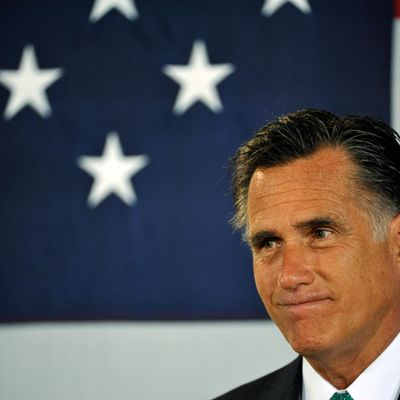
One of the main goals of Mitt Romney’s domestic program, to the extent that it can be discerned, is to transfer programs from the federal government to the states. Just which programs Romney wants to ship to the states, he does not say. But the goal is on his mind, and he has touted it both in private remarks to donors and in his recent speech to a tea-party group last Friday. Perhaps not coincidentally, economist and Romney adviser Greg Mankiw wrote a New York Times column this last weekend touting the virtues of pushing more policy toward the states.
Sometimes, locating policy at the state level can result in some kind of progressive policy innovation. Romney’s Massachusetts health-care plan offers one example. But this was a relatively rare event, brought about by the combination of its being a highly Democratic state that happened upon a large federal windfall unavailable to other states. In most cases, moving a policy to the states will tend to make it more conservative — less generous to the poor and vulnerable, and less burdensome upon the rich and powerful.
How do state programs differ from federal programs? For one thing, they’re paid for differently. Federal taxes charge the rich a higher rate than the poor. State taxes tend to charge a higher rate on the poor than the rich. So even if nothing at all changes about the program, simply breaking one federal program into 50 programs of the same cumulative size amounts to a lump sum transfer payment to the rich from the non-rich.
But making something a state program almost certainly means it will not stay the same size. State governments, unlike the federal government, must balance their budgets every year. When the economy contracts, this forces state (and local) governments into austerity mode. That’s why you’ve seen lots of laid-off teachers and police officers but not many laid-off Marines or IRS agents.
Finally, and most important, states are competing with each other. Every government has a general incentive to provide the best services for the lowest cost. But when you’re a state, you have an additional incentive. You don’t merely want to provide the best general environment, you also want to provide an environment that specifically appeals to business owners and rich people, and repels the poor and sick. After all, rich people may pay a lower average tax rate but they still pay more tax dollars than the non-rich. And poor and sick people suck up tax dollars.
So suppose a state decides it wants to provide really generous services for poor people — say, good medical care (that is, better than your standard Medicaid package) along with child care to help single parents work and scholarships so that any talented but poor kid can go to college. And the voters decide to pay for it by taxing the rich at higher rates. At some point, it will dawn on the voters that, however attractive this arrangement sounds, they may run the risk of driving rich voters into neighborhood states, and, worse still, serve as a magnet for poor and sick people who want to enjoy the comfort and opportunity denied to them elsewhere. All this would make this plan more costly, and possibly altogether unworkable. Indeed, exactly this consideration comes into play all the time when states debate their tax and spending policies.
Interestingly enough, Mankiw makes this argument in his Times column. He does not mention the possibility that offering more generous provisions to the poor and sick may attract more of them to a state. But he does note that, “Because capital is more mobile than labor, competition among governments significantly constrains how capital is taxed.”
In other words, locating more programs at the state level essentially gives the rich and powerful political power disproportionate to their numbers. The voters may agree on a given level of redistribution, but the ease of moving between state lines imposes a constraint that doesn’t exist at the federal level. (Well, it exists in theory — you can move to a different country, but it’s harder, and given that the United States has a less redistributive tax and transfer system than any other advanced country, the option doesn’t really come into play.)
As Mankiw points out, “redistribution is harder when people and capital are free to move to other jurisdictions that offer better deals.” If your goal is to reduce the amount of money that the government takes from the rich and gives to the non-rich, then sending programs to the states makes a lot of sense. And pretty much all the evidence we have suggests this is in fact the Republican Party’s main goal.






























